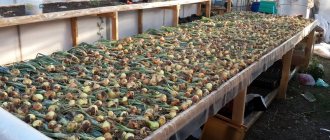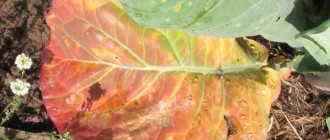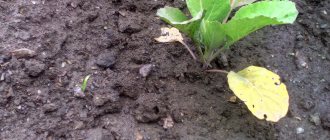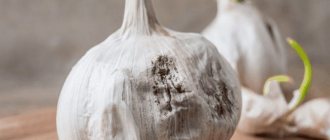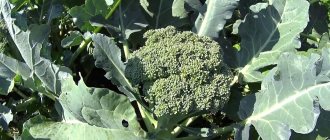Dry rot, or fomoz
Dry rot (fomoz) is one of the most dangerous and widespread fungal diseases of cabbage. Phoma affects cabbage at different stages of development.
Dry rot can affect cabbage seedlings in the same way as blackleg, but unlike blackleg, the cabbage stem at the base does not turn black, but turns gray. Yellowish-gray, slightly indented spots appear on the basal part of the stem, cotyledon leaves, or on the main root. The stem becomes rotten, dries out and becomes covered with black dots of fungal spores. Seedlings infected with gray rot are noticeably stunted in growth, the lower leaves acquire a bluish or purple color, the stem becomes bent, dry rot appears in the root part, and the plants quickly die. Cabbage seedlings infected with dry rot can no longer produce a harvest.
At a later stage of cabbage development, dry rot infection causes dry, depressed spots, sometimes with black dots, to appear on the cabbage stalks.
Dry rot develops especially strongly on seed plants. Affected plants are noticeably stunted in growth, wither and dry out often even before the formation of pods. If the plant survives to produce fruit, the dry rot pathogen penetrates the seeds, concentrating its spores in the surface layers of the shell.
Phoma does not stop its development even when cabbage is stored, especially in conditions of high humidity and elevated temperature. During storage of such heads of cabbage, the ulcers on the heads of cabbage increase significantly, the stumps become rotten and dry out.
Dry rot affects the leaves and pods of seed plants: gray spots with black dots appear on them.
The causative agent of dry rot (fungus Phoma lingam Desm) persists on plant debris, in seeds and stumps. The development of the disease is facilitated by high air humidity (60-80%), warm weather and the presence of damage, especially caused by the cabbage fly.
During one growing season, the causative agent of dry rot can produce from 5 to 8 generations. Dry rot causes great damage to the cabbage crop due to the loss of individual plants, the death of both the outer leaves and the middle of the stem, which has a negative impact on the quality of the product, a shortage of seeds, and a deterioration in their germination.
Preventive measures
If the heads of cabbage have rotted in the garden, they cannot be stored. The infection will quickly spread to other vegetables and destroy the entire crop. Only healthy heads are placed in the cellar, and the room is first thoroughly treated with lime and copper sulfate.
A gardener can use recommendations that will help prevent cabbage from rotting on the vine. What do we have to do:
- Before sowing, treat the seeds and soil in the seedling box with a weak solution of potassium permanganate.
- Highlight seedlings, avoid waterlogging and keep young plants in a room where the temperature does not drop below +15 degrees.
- Avoid dense plantings, maintain a distance of 50–60 cm between plants.
- Plant cabbage in an open space where sunlight can easily penetrate.
- If necessary, reduce the acidity of the soil with wood ash or lime.
- Follow the rules of crop rotation.
- Feed the crop correctly and in a timely manner, remembering that excess nitrogen is harmful to it, especially during the period of ovary formation. At this point, plants need phosphorus and potassium.
- In autumn, it is necessary to remove plant residues from the garden and burn them, as they contain viruses, bacteria and fungi, as well as pest eggs.
- Water correctly, avoid over-moistening the soil and preventing water from getting into the outlet.
- To fight against pests - dust the cabbage beds with wood ash, spray with garlic infusion. In extreme cases, use chemical insect repellents.
- Loosen the soil under the heads of cabbage and remove weeds.
- Use only disease- and pest-resistant cabbage varieties - Slavia, Cambria, Novator, Bukara, Thomas, Eliza, Nozomi.
If cabbage heads or seedlings rot on the vine, the gardener needs to reconsider the quality of plant care, because in most cases, crop diseases are caused by violation of the rules of agricultural technology. It is much easier to prevent rotting. It is important to pay attention to pre-sowing seed treatment and strengthen the immunity of seedlings.
Wet rot, or slimy bacteriosis
The causative agent of mucous bacteriosis is the bacteria Erwinia carotovora subsp. carotovora (Jones) Bergey, Harrison. Mucous bacteriosis of cabbage is a disease that often develops after a sharp change from warm weather (+20-25°C) to rainy cold weather, and primarily on plants damaged by pests or overfed with nitrogen. It is also believed that bacteria can enter cabbage crops with irrigation water. Wet rot most often appears during head setting, first affecting the large petioles of the outer leaves and then spreading to the heads of cabbage.
Areas affected by wet rot become slimy, and an unpleasant fetid odor of rot, characteristic of all bacterioses, appears.
It should be noted that if, when the upper leaves of cabbage heads are affected by mucous bacteriosis, dry weather sets in with low air humidity, then the diseased areas dry out, become thin and transparent.
Sometimes mucous bacteriosis begins to develop from the stump, while it softens and the formation of the head of cabbage stops. With the strong development of mucous bacteriosis, the heads of cabbage fall off the stump before ripening.
Heads of cabbage slightly affected by mucous bacteriosis may seem quite healthy, but sometimes the characteristic smell in cabbage beds gives it away. With timely intervention, it is quite possible to save such heads of cabbage. If nothing is done, then when storing affected heads of cabbage, wet rot causes large losses.
Storing slightly affected heads of cabbage (without visible symptoms of the disease) leads to their further rotting at temperatures above +3...+4°C.
The causative agent of mucous bacteriosis persists in plant debris, in heads of cabbage and in storage rooms, but is not transmitted by seeds. Peduncles do not form on infected heads of cabbage.
If signs of bacteriosis appear on cabbage, nitrogen fertilizing should be avoided. Instead of nitrogen fertilizers, you need to use potassium nitrate: 1-2 tablespoons per 10 liters of water, consumption - 5 liters of solution per 1 m2, moderate watering, when watering it is advisable to pour water only at the root.
What to do if the cabbage is rotting, how to treat it?
There is no way to save rotting heads of cabbage. They must be removed from the site and burned outside. To avoid infection of neighboring plants, the soil is spilled with a solution of copper sulfate at a concentration of 3%. Product consumption – 2 liters per 1 square meter.
Healthy plants are treated with Fitosporin, and the soil under them is disinfected with Previkur or a slightly pink solution of potassium permanganate. At the first signs of the development of bacteriosis, cabbage is sprayed with Bordeaux mixture (1% concentration).
Fitosporin
10–12 days before the expected harvest date, the heads of cabbage are treated with the fungicide Quadris. The solution is prepared at the rate of 5–6 ml of product per 5 liters of water. This measure is aimed at preventing the development of gray rot, which often affects cabbage during storage.
Vascular bacteriosis
Vascular bacteriosis affects not only cabbage, but also cauliflower, Brussels sprouts, broccoli, kohlrabi, as well as radishes and radishes, and it is found on plants in all phases of their development. The causative agent of vascular bacteriosis is the bacteria Xanthomonas campestris pv. campestris Dowson.
The first signs of vascular bacteriosis appear on the cotyledon leaves in the form of lightening of their edges. Plant growth slows down, they bend, wither and may die.
In older plants, vascular bacteriosis causes wilting, yellowing of the ends of the leaves and the appearance of a network of blackened veins on them. On a cut of the veins of leaves and stumps of diseased plants, damage to the vascular bundles in the form of black dots or streaks is clearly visible, which gives the name to vascular bacteriosis - black rot. Later, the affected areas of the leaves become dark brown and die.
In later stages of the disease, the black coloration from the affected leaf may extend to the main stem, where the darkened vascular system may be clearly visible up or down the stem. Affected plants are stunted in growth. The lower leaves fall off, the heads of cabbage remain underdeveloped or lose their marketable appearance.
Vascular bacteriosis progresses during storage, rendering the heads of cabbage unusable. Vascular bacteriosis is often followed by wet rot.
Sources of infection are contaminated seeds, infected plants, including testes, as well as contaminated plant debris. Sometimes weed cabbage plants can also become a source of infection.
During the growing season, bacteria are spread from diseased plants to healthy ones by wind, raindrops, insects and slugs. Bacteria penetrate plants through mechanical damage caused by pests. After this, they easily penetrate the vascular system of plants, causing them to wilt.
The development of vascular bacteriosis progresses with heavy rainfall in the second half of the growing season.
Description of diseases and treatment
It is very important to begin treating diseases as early as possible, otherwise there is a risk of infection spreading to unaffected plants.
Clubroot
The fungal disease affects seedlings, young seedlings planted in open ground, and adult plants. Cauliflower and white cabbage are more often affected. Optimal conditions for the development of the pathogen: air temperature +25-27˚С, humidity 75-90%, soil acidity above pH 6.5.
The fungus can survive in the soil for more than 6 years, is viable in compost heaps with plant debris, and is found in the seeds of diseased plants. The cause of the pathology may be a lack of potassium and calcium in the soil, microelements - boron, manganese.
The fungus first attacks the thin root hairs of the plant, then spreads to the entire root system. Growths form on the thickened roots; when they are destroyed, a huge number of zoospores of the fungus enter the soil.
The main manifestation of the disease is the wilting of the plant during the daytime with sufficient watering. Subsequently, the leaves turn yellow and dry out. As a result of the development of the disease, young seedlings die; if clubroot has developed on adult cabbage, the heads of cabbage will be small and loose.
It is impossible to cure the disease. Measures to contain the spread of the disease :
- watering the bushes with lime milk - 1 tbsp. dolomite flour or 300 grams of slaked lime per 10 liters of water;
- high cultivation of the crop;
- biological products - “Trichodermin”, “Fitosporin-M”, “Alirin-B”;
- fungicides - “Previkur”, “Topaz”.
Infected plants are burned or taken outside the site.
Mucous bacteriosis
Mucous bacteriosis
Pathogenic bacteria infect cabbage when growing seedlings, adult plants, and heads of cabbage during storage. The disease develops at a temperature of +23-30˚С, humidity more than 85%. White cabbage suffers more often than others. In storage facilities, the disease occurs when storage conditions are violated. The pathogens can survive in the soil for up to 7 years.
Oily spots appear on the cotyledons and seedlings - the plant becomes deformed or dies. Adult vegetables are affected through microcracks in the stem. The outer leaves and the base of the stem begin to rot and become covered in mucus with an unpleasant odor. The stalk turns pink, then becomes gray, softens, and the head falls. If the damage is significant, cabbage is not suitable for food.
Medications used for treatment:
- spraying with Fitolavin;
- spraying and watering at the root with biological products - “Fitosporin-M”, “Trichodermin”, “Gamair”;
- dusting plants with Trichodermin and Pseudobacterin.
If a disease is detected, limit the application of nitrogen fertilizers and increase the doses of potassium and microelements.
Downy mildew (downy mildew)
Another name for fungal pathology is downy mildew. The disease often affects cabbage seedlings, especially when grown in greenhouses, but can also appear on an adult plant.
The pathogen is found in seeds or plant debris and is activated when cool and humid weather sets in at +10-18˚C. The development of the disease is promoted by heavy soils with high acidity, excessive watering, and excessive application of nitrogen.
At the beginning of the disease, gray velvety spots appear on the underside of the leaf, gradually merging into large areas. The outer side of the leaf blade turns yellow, and the leaf gradually dries out. As pathology develops, blood vessels are affected and the crop cannot receive moisture and nutrients.
Control measures:
- spraying cabbage with copper-containing preparations - “Hom”, “Oksikhom”, “Ordan”, Bordeaux mixture;
- dusting plants with colloidal sulfur powder 5 grams per 1 m², treating the undersides of leaf blades especially carefully;
- When an infection develops on adult plants, biological products are used - Trichoderma, Vitaplan.
During the treatment period, reduce the number of waterings and limit the application of nitrogen fertilizers.
Fusarium wilt
A fungal disease that attacks cabbage in hot, dry weather. The pathogen can persist in the soil for a long time. The disease begins with the lower leaves, on which yellow spots appear between the veins. Gradually the entire cabbage leaf turns yellow and dries out.
The fungus penetrates the vascular system of the plant, it cannot receive water and as a result withers. Heads of cabbage on diseased cabbage grow underdeveloped and small in size. Without treatment, the plant may die.
Measures to combat mass casualties:
- the crop is sprayed with the preparations “Topsin-M”, “Agat-25”, “Benomil”;
- treatment with copper sulfate - 5 grams per 10 liters of water.
Having discovered one diseased plant, it is removed and taken outside the garden area.
Vascular bacteriosis
The disease, caused by pathogenic bacteria, affects cabbage at the stage of seedling development (when grown in greenhouses), adult plants, and seeds. The pathogen remains virulent for up to 2 years, and is activated in hot +25-30˚C, humid weather.
Often the disease is caused by sudden daily temperature changes. The bacteria can be carried by wind and insects.
Pathogens penetrate into the plant through microcracks and stomata of leaves, infect blood vessels, depriving the plant of nutrition. On seedlings, yellowing of the cotyledons is observed, most of the young seedlings die. In mature cabbage, the edges of the leaves turn yellow with simultaneous darkening of the veins. A dark vascular ring is clearly visible on a cut of the petioles and stalk. Diseased plants form small loose heads of cabbage.
Control measures:
- spraying with a 0.1% solution of the agrochemical “Planrez”;
- spraying and watering with Fitolavin and Fitosporin-M preparations;
- single treatment with copper-containing pesticides - “Oxyx”, “Hom”, “Ordan”.
Lack of treatment leads to a significant decrease in crop yield, sometimes to plant death.
Alternaria (black spot)
The disease affects cabbage at all stages of development. The pathogenic fungus is carried by water and wind and develops on wet cabbage leaves at a temperature of +20-27˚С. Black streaks and dots appear on the leaves, which gradually merge into large spots with a yellow edging, covered with a loose sooty coating.
The disease leads to massive rotting of leaves. The fungus overwinters in plant debris and can survive in crop seeds.
Effective means:
- “Bravo”, “Quadris”, “Skor” - spraying once every 2 weeks;
- 5-7 grams of copper sulfate are diluted in 10 liters of water, and treatments are carried out every 10-12 days.
Watering the roots with an infusion of wood ash, Trichodermin, helps to restrain the development of the disease.
Fomoz (dry rot)
The causative agent of the disease is an aggressive pathogenic fungus that affects all parts of the plant: roots, stems, leaves, seeds. Optimal development conditions: temperature +22-25˚С, high humidity, heavy morning dew.
The pathogen enters the plant through damage caused by pests. Fungal spores overwinter in plant debris and soil and can remain viable for a long time. They reach the crop with wind and moisture and are carried by harmful insects.
In seedlings, the cotyledons are affected - gradually increasing light spots appear. Adult bushes become sick at the time of head formation. At the base of the stem, a depressed, light brown ulcer forms with black dots inside - the fruiting bodies of the fungus. As the disease progresses, the lower leaves die, the root system is destroyed, and the cabbage withers and dries up.
When the first signs of the disease appear, medications are used:
- 1% Bordeaux mixture;
- copper-containing fungicides - “Ordan”, “Oksikhom”.
Preventive spraying of plants with biological products “Fitosporin-M” and “Trichodermin” is recommended throughout the growing season.
White and gray cabbage rot
They develop on crops at the end of the growing season or during storage. Pathogenic fungi remain viable in plant debris or soil for several years. The progression of the disease is facilitated by high humidity and cold morning dew.
Sclerotinia (white rot) - the outer leaves of the head of cabbage become covered with a white, weeping coating and begin to rot. The pathogen quickly spreads throughout cabbage plantings.
Botrytis (gray rot) is a fluffy gray coating. The fungus penetrates plant tissue due to mechanical damage and freezing of leaves. The fungus releases toxins that cause necrosis of the affected tissues.
Control measures:
- destroying affected areas on heads of cabbage, dusting plants with activated carbon or cinnamon;
- spraying with “Switch”, “Blue Bordeaux”, “Skor” preparations as prophylactic agents;
- “Fitosporin-M” - spraying once every 2 weeks throughout the growing season;
- adding zinc sulfate and boric acid to the soil.
Timely harvesting of the crop while preserving the covering leaves, maintaining optimal temperature and humidity in storage helps to avoid the occurrence of diseases.
Blackleg
A fungal disease that can lead to massive death of seedlings. Adult plants survive, but are significantly delayed in development. Fungal spores overwinter in the soil and are activated in conditions of high humidity. The risk of pathology increases with insufficient lighting, dense plantings, lack of root aeration due to soil crust, and increased soil acidity.
Most often, the fungus attacks seedlings. The stem of the seedlings becomes watery, thins, and then turns black. The plant dies, followed by infection of other seedlings. On mature cabbage, blackening of the root collar is observed.
Ways to fight the disease:
- spraying with 1% Bordeaux mixture;
- treatment with Previkur Energy 25 ml per 10 liters of water;
- spraying plants and soil with Fitosporin-M and Trichodermin;
- watering the plants with an infusion of onion peels, a solution of baking soda - 1 tbsp. l. per glass of water.
Before planting cabbage seedlings, the soil is disinfected by steaming in the oven at a temperature of +100˚C for 20-30 minutes or spilled with solutions of potassium permanganate, “Fitosporin-M”.
Rhizoctoniosis
Fungal disease develops in conditions of high humidity, sudden changes in air temperature, and increased soil acidity. The fungus is viable for a long time in soil and unharvested plant debris.
The disease often affects young seedlings after planting seedlings in open ground. The root collar becomes thinner, ulcers appear on the stem, and brown spots appear on the leaves. When adult plants are damaged, the leaves turn yellow, easily separate from the stalk, and the roots die. The head of cabbage may fall off the stem. The disease may continue to develop during the storage phase.
Control measures:
- spraying - preparations “Fitolavin”, “Baktofit”, “Planriz”;
- treatment with copper-containing fungicides - “Ordan”, “Oxyx”;
- preventive spraying with Glyokladin and Trichodermin.
A good effect is achieved by dipping the roots of the seedlings into a mash of clay and mullein diluted with water.
Cabbage mosaic
A viral disease transmitted by various types of aphids. In the initial phase of the disease, parts of the leaf become discolored and curl. Then the veins turn yellow, dark specks appear on the leaves - traces of necrosis. The plant is delayed in development and dies after 1-1.5 months.
The disease cannot be cured; infected bushes must be destroyed. Timely control of aphid colonies with insecticides “Iskra-M”, “Decis-Profi”, spraying plants with an infusion of ash or tobacco dust helps to avoid damage.
Black spot, or cabbage Alternaria
Black spotting appears on both young and adult cabbage plants, especially on the seeds - during their ripening and harvesting.
Black necrotic stripes and spots form on the cotyledon leaves and stems of cabbage seedlings. In older cabbage plants, dark necrotic zonal spots up to 10 mm in diameter, with a loose black coating resembling soot, form on the upper leaves of the heads of cabbage. The affected tissue may fall out over time, causing holes to form on the leaves. With severe development of black spot, the covering leaves of cabbage die off. The disease is caused by the fungi Alternaria brassicae Sacc. and Alternaria brassicicola Wilts.
The development of black spot is promoted by an abundance of precipitation, relative air humidity of 80-100%, air temperature +20...+25°C and dense plants. The incubation period of Alternaria at a temperature of +25°C is only 1-2 days.
Sources of Alternaria infection are plant debris. In addition to white cabbage, these pathogens affect not only cabbage plants and weeds from the cabbage family, but also many other vegetables (potatoes) and ornamental crops (juniper).
Why does cabbage rot from the stalk?
A dangerous enemy of culture is mucous bacteriosis, or wet rot . The disease has 2 variants of its course, one of which is the penetration of bacteria through damage to the upper leaves. In this case, microorganisms reach the stalk and soften it, causing the head to fall off.
Several factors provoke the development of wet rot:
Most often, mucous bacteriosis affects the plant in the second stage of the growing season .
Gray rot of cabbage
When infected with gray rot (botrytis), cabbage heads become soft and gray mold appears on the leaves. Heads of cabbage affected by gray rot most often rot in storage, starting with the lower leaves, especially if these leaves are wilted or frostbitten.
Gray rot of cabbage is less common dry and wet, although in some warm, humid years, if there is an infection in the soil and storage areas, it can cause significant harm.
Signs of defeat
The initial stage of the disease is very difficult to notice. Infected cabbage growing in a garden bed can have two options for the development of the disease:
- Covering leaves rot. The outer leaves darken, become covered with mucus and emit a rotten smell. Slowly and surely, bacteriosis takes over the entire head of cabbage, which leads to the inevitable death of the plant.
- The spread of infection begins from the stalk. In this case, pathogenic microorganisms infect the stalk through the soil or insects. It changes color to dark and becomes softer. The disease progresses quickly, the inner leaves become dirty cream in color, soften and eventually the head of cabbage falls off.
During cabbage storage, rot goes unnoticed for a long time. The inner part of the stalk gradually decomposes and turns into a slimy mass with a putrefactive odor. It is possible to detect bacteriosis when most of the head of cabbage is affected.
Clubroot cabbage
Clubroot is a fungal disease that affects the root system of all types of cabbage, turnips, radishes, radishes, and sometimes rutabaga. Clubroot appears on the roots of plants in the form of growths and swellings ranging in size from a large pinhead in seedlings to an apple in adult plants. Kidney-shaped thickenings on the roots when cabbage is infected with clubroot can easily be confused with the galls of the secretive proboscis.
Plants become infected at the very beginning of their development, through the soil, where clubroot spores persist for several years. Clubroot develops most strongly on heavy clay and acidic soils. Cabbage seedlings affected by clubroot are almost no different in appearance from healthy ones. Cabbage plants affected by clubroot at an older age are severely stunted in growth, wither and die.
The fungus that causes clubroot persists in the soil for a long time. Therefore, cabbage and other cabbage plants are planted in the same bed after 5-7 years, the soil is constantly loosened and mustard or oilseed radish is not used as green fertilizer.
If clubroot appears on the site, monitor the acidity of the soil. Direct control of clubroot is almost impossible. For prevention, they lime the soil to reduce acidity, trying to bring the soil pH to 7.0. Additionally, lime is added to the holes when planting cabbage.
How to protect cabbage from rotting
Rotting of cabbage during the growing season is primarily due to improper agricultural practices: failure to observe crop rotation, dense planting, irregular watering of plants, and lack of treatments against diseases and pests. How to prevent the appearance of rot and what to pay attention to when growing cabbage in order to get healthy heads of cabbage?
1. Maintain crop rotation. Cabbage can be returned to its original place no earlier than after four years. The best predecessors of this crop are beans, cucumbers, carrots, potatoes, onions, garlic, tomatoes, and peppers. In the area where cabbage will be grown in the coming years, grain crops or legumes should be sown as green manure and in no case cruciferous crops.
2. Treat seeds, seedlings and soil with biofugicides based on Bacillus subtilis or Trichoderma. To prevent the development of mucous bacteriosis and at its first manifestations, treat plants with a 0.1% working solution of the biological product Planriz every 20 days.
3. Protect cabbage from pests during the growing season. The white moth, cutworm, cruciferous flea beetle and other insects are carriers of diseases. In addition, caterpillars gnaw leaves, and damaged heads of cabbage are more often affected by phytopathogens.
4. Apply mineral fertilizers correctly. Excessive amounts of nitrogen fertilizers cause cabbage to be stored worse and rot more often. Therefore, you should give preference to potassium-phosphorus fertilizers or add a handful of ash to each hole before planting cabbage. This will also help reduce the acidity of the soil and prevent the development of such a dangerous cruciferous disease as clubroot.
5. Remove weeds and all plant debris from the area where the cabbage grew. Leaves with signs of disease, rotten heads of cabbage, and stumps should not be placed in the composter - they should be taken off site or burned.
6. Grow varieties and hybrids resistant to cruciferous diseases: Cossack F1, Podarok, Mara, Snow White, Airbus F1, Gallaxy F1, Kolobok F1, Paradox F1, Extra F1, etc.
Cabbage should be harvested in dry weather, and only well-ripened and healthy heads of cabbage can be stored, leaving the outer leaves on them. Damaged heads should be eaten as quickly as possible or used for winter preparations.
Source
Rhizoctonia of cabbage
Rhizoctonia blight is a fungal disease of cabbage caused by the fungus Rhizoctonia solani. The pathogen is not picky about environmental conditions, so cabbage rhizoctonia can develop under large fluctuations in temperature (from +3 to +25°C), soil moisture (from 40 to 100% of total moisture capacity) and substrate acidity (pH from 4.5 to 8 ). The fungus does not have a dormant period.
When the causative agent of rhizoctonia gets on the root collar of cabbage seedlings, the stem turns yellow, dries out and dies, and the cabbage seedlings die.
If the disease started from the leaves, then small round spots of yellowish-orange color form on the affected cotyledon leaves.
If the roots are affected, they become soaked, but with constant hilling of the cabbage above the affected area, additional roots can form.
Infection with rhizoctonia occurs when contaminated soil gets on cabbage leaves or when the leaves come into contact with the ground. On cabbage leaf petioles, oblong, deep, light brown sores up to 2–2.5 cm long are formed. Large, vague brown spots form on leaves in contact with the soil after infection.
Rhizoctonia continues to develop on affected heads of cabbage during storage. In this case, the leaves on the infected head of cabbage are easily separated from the stalk, which significantly reduces the weight of the heads of cabbage.
The fungus is preserved in the ground and on plant debris. The duration of preservation of fungal spores in soil without a host plant is 5–6 years. Throughout this period, the causative agent of rhizoctonia retains its pathogenic properties. Rhizoctoniosis is a very insidious and dangerous disease that can infect many vegetable crops, for example potatoes, in which the disease causes damage to tubers, also called black scab.
Insect pests
Enormous damage to the crop is caused by insect pests that feed on immature plants. They are active already in the spring, causing harm to seedlings. In addition to the fact that pests themselves spoil the plants, they can infect them with a fungal or viral infection. Therefore, in order to grow a good harvest of cabbage, it is necessary to constantly fight against parasitic insects.
Cabbage aphids: 30 photos, how to treat them (control measures)
Aphids on cabbage. If you do not regularly treat plants, they will become infected with parasites, which are much more difficult to remove than to take preventive measures. Such a pest is aphids that feed on cabbage juice. This is a small silvery-white insect that is located on the underside of leaves and feeds on the sap of the plant. The pest is both a larva and an adult insect. The peak of harmfulness is August. As a rule, aphids settle on plants in entire colonies. Its presence can be determined by the following signs: plant growth slows down, the leaves acquire a pinkish tint, and over time the leaves curl and wither. When aphids multiply massively in the southern regions, crop loss can reach colossal proportions.
25 photos of what aphids look like on cabbage:
Control measures and drugs.
Control of aphids should begin before heads begin to form to minimize damage. To combat aphids, the drugs Iskra, Karate, and Karbofors are used. Also, aphids cannot tolerate the smell of garlic, onions, tobacco, as well as tomatoes and carrots. In addition, a necessary pest control measure is the destruction of weeds and plant residues after harvesting. Natural enemies of aphids are ladybugs, lacewings and aphidiid parasites.
Cabbage fly: 25 photos, preparations and control methods
Cabbage, both cauliflower and white cabbage, can be attacked by a parasite such as the cabbage fly. In appearance, it is almost no different from an ordinary housefly, it is only smaller in size and lighter in color. From the end of spring, she lays eggs in the ground, and the hatched larvae begin to devour the roots of plants. As a result, the roots begin to rot, the bushes wither, and the leaves turn gray. The cabbage fly is a fairly tenacious insect and can produce offspring that can survive even a cold winter.
25 photos of what a fly on cabbage looks like:
Control measures and drugs.
- A 30% Typhos solution with a concentration of 0.03% is used against flies.
- Also very effective is 65% Chlorophos, used at a concentration of 0.25%.
- Lime, tobacco and mothballs with sand will help repel flies.
- It is also necessary to observe crop rotation and dig the soil deeply.
Cruciferous flea beetles on cabbage: (20 photos) how to fight and how to treat them
This is one of the most dangerous pests of cabbage, since a large colony of beetles can destroy the entire crop in the shortest possible time. Flea beetles are small bugs that live in the ground. They are black, striped, with a bluish and greenish tint. They are able to jump several meters, covering long distances. They overwinter in the ground. In the spring, they begin to eat young shoots, both weeds and seedlings. Fleas wake up at a temperature of +15 °C. This insect parasitizes all types of cruciferous plants, eating the top layer of the leaf and leaving holes behind. The beetle larvae eat the roots. Young plants often die, and older plants produce poor harvests.
25 photos of what cruciferous flea flea on cabbage looks like:
How to fight and what to treat
Insecticides such as Aktara, Karbofos, Sherpa, Arrivo, Decis, Molniya help against fleas. The safest drug is naphthalene.
Traditional methods
And among the folk methods - spraying with a soap or vinegar solution, tobacco infusion, dandelion solution, garlic-tomato tincture, potato decoction, sprinkling with ash and dust. It is necessary to regularly destroy cruciferous weeds (colts, shepherd's purse, wild mustard), dig up and plow the soil. Fleas also cannot tolerate moisture.
Fusarium wilt, or tracheomycosis of cabbage
The causative agent of the disease is the soil fungus Fusarium oxysporum (syn. F. conglutinans), which retains its viability for several years. Fusarium wilt is a very dangerous fungal disease. Cabbage is most vulnerable to Fusarium wilt during the period of growing seedlings and planting them in open ground. During this period, Fusarium wilt can destroy up to 20-25% of the total number of plants.
The main sign of Fusarium wilt is the yellow-green color of the leaves and loss of turgor. Diseased leaves fall off, the head of cabbage becomes distorted, and with severe damage, only a small bare head of cabbage, devoid of outer leaves, remains. The fungus enters the plant through the roots or through damage caused by pests, spreads through the vessels to the aboveground part and significantly impedes the movement of water in the plant.
Massive wilting of cabbage is observed in years with hot summers. Optimal conditions for the development of the fungus occur when the soil warms up to +15 +17oC. Air temperature and humidity do not have a significant effect on plant infection.
Fusarium
Fungal diseases of cabbage are very common, and combating them is not difficult if detected and treated in a timely manner. Fusarium is such a disease.
The causative agent of Fusarium wilt or tracheomycosis is the fungus Fusarium oxysporum f. sp. conglutinans. The disease affects all types of cruciferous crops. The fungus, penetrating into the vascular system of plants, clogs it, causing wilting. This disease is popularly called jaundice due to the characteristic symptoms:
- yellow spots appear between the veins;
- gradually the entire leaf turns yellow and dries out;
- on the cut of the base of the leaves, brown spots are visible - the mycelium of the fungus;
- the established head of cabbage is very small and has an irregular shape.
As with all fungal diseases, in case of Fusarium wilt it is recommended to remove infected plants and treat the plantings with systemic benzimidazoles fungicides: Benomyl, Tecto, Topsin-M.
The fungus can maintain its vital activity in the soil for several more years, so it is necessary to follow the rules of cabbage crop rotation - do not plant in one place several times in a row, and also remove plant debris from the soil.
Downy mildew or downy mildew of cabbage
Cabbage downy mildew is a fungal disease caused by the fungus Peronospora parasitica brassicae. Downy mildew is most harmful to cabbage seedlings and seed plants. The first signs of downy mildew damage appear on the cotyledon leaves of seedlings in the form of yellowish blurry spots; in the same place, a grayish-white coating of sporulation of the fungus forms on the underside of the leaf. Gradually the leaves turn yellow and die.
The source of the disease can be seeds, soil, plant debris in greenhouses, nurseries. For the development of downy mildew, the favorable temperature is +20 +22°C. After planting cabbage seedlings in open ground, the development of downy mildew stops, although the fungus remains in the plant. In humid weather, downy mildew again appears on cabbage leaves in the form of reddish-yellowish spots with a coating of mycelium on the underside. Downy mildew can also affect other vegetable crops, for example, onions, peas, cucumbers, melons, watermelons, and pumpkins.
Cabbage leaves are rotting: how to save the harvest
Adding an article to a new collection
Like many other vegetable crops, cabbage is often affected by rot. It is especially unpleasant to discover the disease at the very end of the season, when it is time to harvest. What to do if trouble comes to your garden?
Cabbage is one of the most popular garden crops. Many summer residents even grow cabbage varieties of different ripening periods on their plots. Early ones - in order to use it for cooking in the summer, late ones - to lay the heads of cabbage for storage in the autumn. Most often, it is the latter that fall victim to rot. First, let's outline the circle of “suspects” that most often cause cabbage rot.
Darkening in the middle of the head
Darkening in the middle of the head of cabbage is not a disease. The reason for such damage to the cabbage is prolonged exposure to low temperatures on the cabbage in the garden or in storage. Although cabbage can tolerate short-term frosts down to –8 oC without visible consequences, autumn frosts are often severe and long-lasting.
Cold damage to cabbage is often irreversible. Several layers of leaves inside the head of cabbage become glassy, while the outer leaves have a completely healthy appearance. After some time, the affected leaves inside the head of cabbage acquire a reddish or reddish tint (this damage to cabbage is called “red heart”), and when exposed to heat, they can turn black, emitting an unpleasant odor. Similar symptoms may occur in cabbage storage areas with low oxygen levels and high carbon dioxide levels.
Cabbage damaged by frost cannot be stored. The top healthy leaves of frozen cabbage can be processed or used in food.
To avoid exposing cabbage to sub-zero temperatures, the crop must be harvested before the approaching severe frost. For long-term storage, cabbage is harvested before sub-zero temperatures occur.
When there is frost (–3–4oC), mid-season cabbage is usually harvested and used for pickling. A short-term decrease in temperature improves the taste of cabbage, it becomes sweet and juicy, which is why sauerkraut is so tasty.
Fighting methods
To protect cabbage from rotting, you need to avoid excess nitrogen in the soil; the rule is appropriate here: it is better to underfeed than to overfeed. It is very important to follow the rules of crop rotation and agricultural technology. It is advisable to choose varieties that are resistant to diseases for cultivation. It is best to plant cabbage after beets, peas, and beans, but not after related crops.
You need to water cabbage regularly and correctly - if the water does not reach the roots, but collects from above, then it does not nourish the plant, but only contributes to the rotting of the leaves. When watering, the water should not be colder than the air, and watering itself should be done in the morning or evening.
In any weather, it is necessary to monitor the condition of the soil around the plants, the soil must be loosened, and weeds must be pulled out. Excessive shade promotes moisture concentration, which means it attracts slugs, snails and other pests, and contributes to the spread of fungal pathogens.
Aphids and cutworms are a nuisance themselves, but they can also spread bacteria that cause rot. If you plant plants that repel insects among the cabbage, dust them with wood ash, and monitor the condition of the cabbage heads, you can minimize the damage caused. It is better to remove diseased plants from the garden along with the roots as soon as possible in order to stop the spread of diseases.
Only absolutely healthy heads of cabbage should be stored for storage and the correct storage regime should be observed. The temperature in the cellar should be maintained between zero and -1 degrees. Before planting the crop, the room must be disinfected using bleach and copper sulfate.
It's always unpleasant when the harvest in the garden disappears. And if cabbage rots, it’s a pity not only for the lost time, but also for the fertilizers applied: this vegetable consumes a lot of nutrients. If you grow cabbage correctly, rotting of the heads can be avoided.
Cabbage mosaic
Chaotic yellow spots, streaks, rings appeared on cabbage leaves - this may be a manifestation of viral mosaic . Mosaic can affect almost all types of cabbage, as well as radishes, radishes, rutabaga, and turnips. The virus is transmitted to plants by sucking insects: aphids, thrips, spider mites.
There are no means of combating cabbage mosaic; you need to fight insect pests. If mosaic appears on cabbage leaves, all plants with a mosaic pattern will have to be removed and destroyed to prevent the mosaic from spreading to other plants. As a preventive measure, spraying with insecticides can be suggested.
The main causes of rotting cabbage on the vine
There are 3 main reasons why cabbage heads begin to rot in the garden. These include:
- violation of agricultural technology rules;
- adverse weather conditions;
- cultural diseases.
Each of the points is directly or indirectly related to the other. For example, when it rains for a long time, ideal conditions are created for the proliferation of bacteria that cause plant diseases at the stage of seedling development or head formation.
Incorrect agricultural technology
This culture cannot be called too capricious, but it loves constancy and moderation in everything. Gardeners who violate agrotechnical requirements risk losing their harvest before they have time to remove it from the garden.
Common causes of cabbage rotting associated with improper care:
- Cabbage is planted in the shade or too densely, so that overgrown leaves interfere with normal air circulation and block sunlight.
- Neglecting the procedure for loosening the soil. This leads to the formation of a dense earthen crust under the heads of cabbage, as a result of which moisture is retained at the roots.
- Failure to follow crop rotation recommendations. The soil contains microorganisms that cause cabbage diseases.
- Excess nitrogen fertilizers.
- The culture develops on acidic soil. Cabbage grows well and suffers less in soil with a neutral or alkaline reaction.
- The seeds were not properly prepared for sowing; they were not disinfected.
- Over-wetting the beds or getting water into the outlet when watering.
Attention! In most cases, cabbage rots on the vine precisely because of errors in agricultural technology. To grow a good harvest, you need to follow the recommendations for caring for the crop.
Weather conditions that provoke the development of rot
Rotting can be caused by bad weather. Gardeners note that frequent rainfalls often cause rotting of the lower leaves. If the soil does not have time to dry out, then the stalks will deteriorate in the future. It is almost impossible to preserve the harvest in such conditions. Removing leaf blades that are in contact with the ground will help protect the heads of cabbage from spoilage.
Rotten cabbage
Heat can also indirectly affect the development of rot on cabbage. When warm weather sets in, pests actively multiply. They attack plantings and damage leaves and stems of plants, opening the gates for infections, including bacteria that cause rotting. To avoid this, it is necessary to deal with insects and their larvae immediately. Hot weather combined with high humidity often leads to cabbage becoming infected with bacterial diseases.
